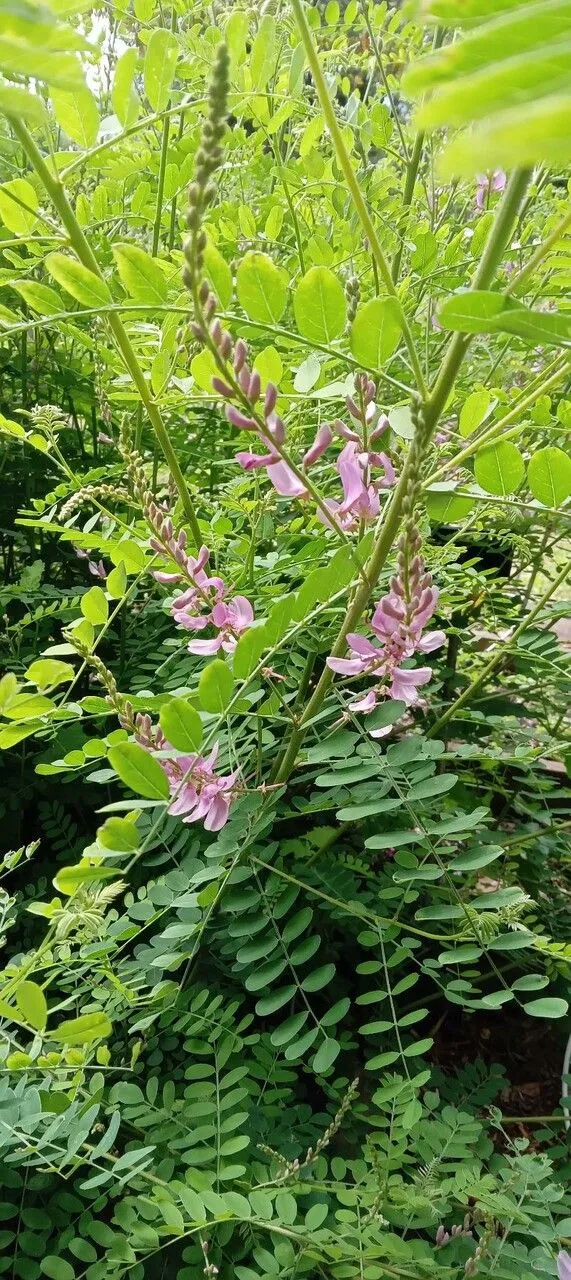
Author: (L.) DC.
Bibliography: Prodr. 2: 328 (1825)
Year: 1825
Status: accepted
Rank: species
Genus: Desmodium
Vegetable: False
Observations: SE. Canada to C. & NE. U.S.A.
Showy tick trefoil, scientifically known as Desmodium canadense, is a remarkable perennial plant native to southeastern Canada as well as central and northeastern United States. Belonging to the Fabaceae family, this species was first documented in the Prodr. 2: 328 by the botanist (L.) DC. in 1825.
Desmodium canadense, or Showy tick trefoil, is well-regarded for its striking visual appeal and ecological benefits. This herbaceous plant typically grows in meadows, prairies, and along roadsides, thriving in diverse soils, including those that are sandy or loamy. It can reach a height of up to 2 meters, making it a noticeable presence in its natural habitat.
The most distinguishing feature of Showy tick trefoil is its vibrant, pink to purplish flowers which bloom in mid to late summer. These flowers are grouped in elongated, loose clusters known as racemes. Each individual flower is delicate and pea-like, reflecting the plant’s membership in the legume family. The flowers are particularly attractive to various species of bees and butterflies, making Desmodium canadense an important plant for pollinators.
Beyond its aesthetic appeal, Showy tick trefoil exhibits significant ecological advantages. Like other members of the Fabaceae family, it engages in a symbiotic relationship with nitrogen-fixing bacteria in the soil. This relationship enriches the soil by increasing its nitrogen content, thus improving its fertility and benefiting surrounding plant life.
Additionally, Desmodium canadense is valued for its role in preventing soil erosion. Its deep root system stabilizes the soil, making it an excellent choice for land restoration projects. The plant’s foliage provides habitat and food for wildlife, including small mammals and various bird species.
In summary, Showy tick trefoil is not only a visually captivating plant with its charming pink to purplish flowers but also an ecologically valuable species that supports pollinators, improves soil fertility, and prevents erosion. Its presence in southeastern Canada and central to northeastern United States highlights its adaptability and significance in these regions.
Eng: canada tickclover, canadian tick trefoil, showy tick trefoil, showy ticktrefoil, canada tick-trefoil, canada tick-clover, showy tick-trefoil
Swe: lusväppling
Fra: desmodie du canada
En: Showy tick trefoil, Canadian tick trefoil, Showy ticktrefoil, Showy Tick-Trefoil, Canada tickclover, Canada tick-trefoil, Canada tick-clover
Fr: Desmodie du Canada
Sv: Lusväppling
Taken Jul 1, 2022 by Esuma (cc-by-sa)
Taken Jun 8, 2022 by Fabrice Rubio (cc-by-sa)
Taken Aug 10, 2022 by Aaron Winston (cc-by-sa)
Taken Sep 15, 2022 by Dustin Miller (cc-by-sa)
Taken Sep 5, 2022 by Cathy Kavassalis (cc-by-sa)
Taken Aug 1, 2021 by Ed Lehming (cc-by-sa)
Taken Sep 27, 2021 by Neeraj Neeraj Tiwari (cc-by-sa)
Taken Sep 12, 2021 by Jake Gaster (cc-by-sa)
Taken Aug 15, 2020 by Sarah Ines (cc-by-sa)
Taken Jul 30, 2021 by Cole OBrien (cc-by-sa)
Taken Jul 18, 2014 by EOL − Kyle Jones (cc-by-nc)
Taken Jul 7, 2013 by EOL − Kyle Jones (cc-by-nc)
Taken Jul 7, 2013 by EOL − Kyle Jones (cc-by-nc)
Taken Jul 10, 2015 by EOL − Aarongunnar (cc-by-nc)
Taken Jun 8, 2022 by Fabrice Rubio (cc-by-sa)
Taken Aug 19, 2022 by Richard Wideman (cc-by-sa)
Taken Jul 8, 2019 by lisbon levi (cc-by-sa)
Taken Sep 5, 2022 by Cathy Kavassalis (cc-by-sa)
Taken Sep 15, 2022 by Dustin Miller (cc-by-sa)
Growth habit>: Forb/herb
Family: Myrtaceae Author: (F.Muell.) K.D.Hill & L.A.S.Johnson Bibliography: Telopea 6: 402 (1995) Year: 1995 Status:…
Family: Rubiaceae Author: Pierre ex A.Froehner Bibliography: Notizbl. Bot. Gart. Berlin-Dahlem 1: 237 (1897) Year:…
Family: Sapindaceae Author: Koidz. Bibliography: J. Coll. Sci. Imp. Univ. Tokyo 32(1): 38 (1911) Year:…
Family: Asteraceae Author: A.Gray Bibliography: Pacif. Railr. Rep.: 107 (1857) Year: 1857 Status: accepted Rank:…
Family: Fabaceae Author: Medik. Bibliography: Vorles. Churpfälz. Phys.-Ökon. Ges. 2: 398 (1787) Year: 1787 Status:…
Family: Aspleniaceae Author: (Cav.) Alston Bibliography: Bull. Misc. Inform. Kew 1932: 309 (1932) Year: 1932…